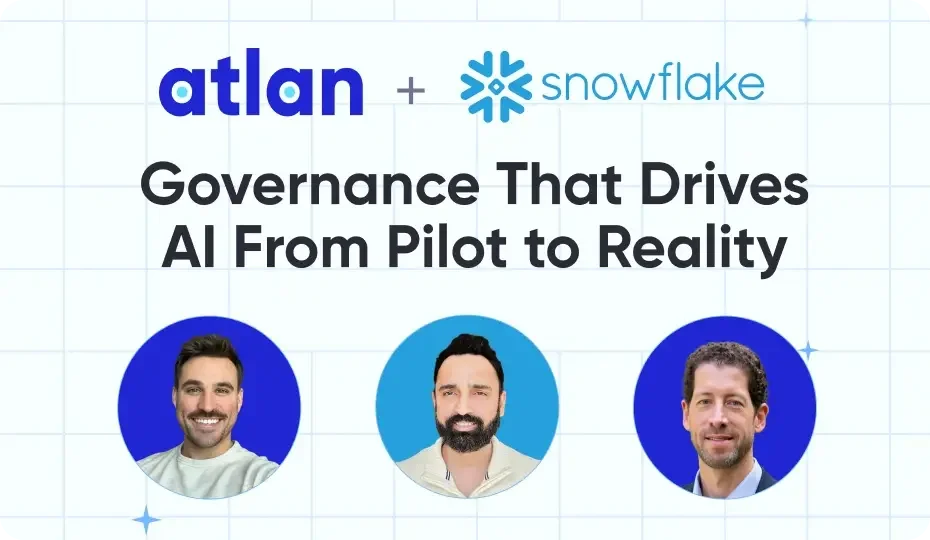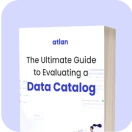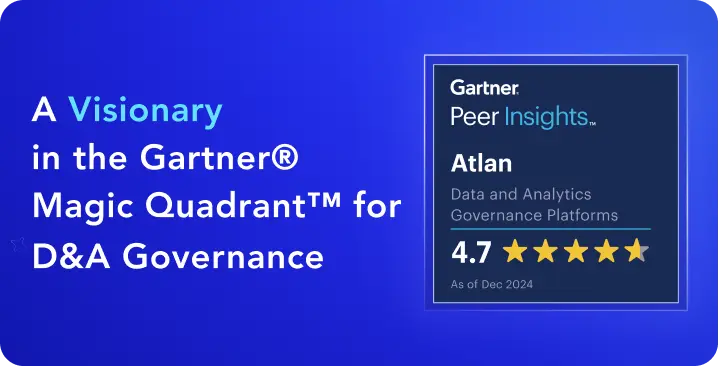AI Risk Management: How to Build a Framework for Mitigating AI Risks
Share this article
How do you effectively manage the risks associated with AI systems?
#
As AI adoption increases across industries, organizations face new challenges in managing the risks of AI, from data security to ethical concerns. This guide will show you how to build a robust AI risk management framework and mitigate common risks such as model safety, privacy issues, and regulatory compliance.
Key Risks of AI:
- Data security vulnerabilities
- Model safety threats (e.g., prompt injection attacks)
- Ethical and reputational risks
- Governance complexity and management challenges
Unlock Your Data’s Potential With Atlan – Start Product Tour
Between 2023 and 2024, AI systems saw rapid adoption across various sectors. A 2024 McKinsey survey revealed that 65% of respondents were using AI in their operations. As AI technology evolves, more organizations are finding ways to integrate it into their workflows.
While AI promises transformative potential in products and productivity, it also introduces significant risks. Traditional risk management approaches may not be sufficient for this new technological landscape— new strategies are needed to effectively manage the complexities of AI.
This article will explore the various risks associated with AI, provide guidance on how to manage them, and demonstrate how Atlan’s AI management tools can help safeguard your AI systems.
Table of contents #
- How do you effectively manage the risks associated with AI systems?
- What is AI Risk Management?
- What are the risks of AI?
- How to mitigate the risks of AI?
- Features of an AI risk management framework
- Atlan for AI management
- Conclusion
- FAQs on AI risk management
- AI Risk Management: Related reads
What is AI Risk Management? #
AI risk management is the process of identifying, assessing, and mitigating potential risks associated with artificial intelligence systems. These risks can range from data security vulnerabilities and model safety issues to ethical concerns and regulatory compliance challenges. By implementing a comprehensive AI risk management framework, organizations can ensure the safe and responsible use of AI technologies, minimizing potential harms while maximizing benefits. Effective AI risk management helps organizations navigate the complexities of AI adoption, ensuring that systems are secure, compliant, and aligned with ethical standards.
What are the risks of AI? #
Privacy, safety, and compliance are important considerations when handling any data. Many organizations already have risk management systems in place to manage these data issues. However, AI systems’ unique architecture introduces new dimensions of risks to data systems.
AI risks fall into four major categories:
- Data security risks
- Model safety risks
- Reputational, ethical, and compliance risks
- Complexity risks
Data security risks #
Traditional data systems have a direct relationship between data and interface. If you query a database, it provides data exactly as specified by your request.
However, AI systems are different. The link between a prompt and the model response is indirect. Additionally, these systems can exhibit unexpected or unusual behavior. These can range from inventing (“hallucinating”) answers in the absence of data to making promises a business can’t keep (such as offering to sell a car for a dollar).
This indirect relationship makes data security much more difficult. If a model has access to sensitive data, it’s hard to guarantee that it can’t be coerced into sharing it. A certain series of prompts may expose sensitive information even if that behavior wasn’t a part of the model’s design.
Even worse, AI systems require significant volumes of data to function. Scaling data security is already difficult. Combining that with the unclear behavior of models creates a hotbed for potential data security breaches.
Model safety risks #
AI models have vulnerabilities beyond their underlying data. Direct lines of attack on models themselves also exist that can cause them to break or act in harmful ways.
One common attack on models is prompt injection: giving an AI model inputs that cause it to malfunction, shut down, or produce dangerous outputs. Depending on how connected this model is to the rest of the data system, there’s potential for serious damage.
Since model computations are obscured, tracking which prompts are dangerous is often a matter of trial and error. Managing the safety of a deployed model requires ongoing observation and adjustment.
Ethical, reputational, and compliance risks #
Poorly deployed AI systems can produce erratic behavior that directly harms users – for example, a medical chatbot that provides people with incorrect or hallucinated advice. Without proper risk management, you could release a product that hurts your users instead of helping them.
Ethical blunders like this hurt your reputation, driving users away and creating an image of irresponsibility. Once you lose that trust, it’s an uphill battle to win it back.
Because of the serious potential for harm, countries worldwide are giving AI systems legal attention: updating old laws like copyrights and developing new regulations - such as the EU AI Act - specifically around AI. You need to be sure that your AI systems are updated with this shifting compliance landscape before you deploy them.
Complexity risks #
AI systems are complicated both for users and developers. Understanding how they work and how to leverage them requires significant learning and practice.
This complexity puts AI systems at risk of deterioration: users bouncing off the system as they get frustrated with its opacity or development teams losing track of the intricacies of a product as team members come and go.
Since the functioning of an AI system is obscured, it’s difficult to track accountability for the behavior of a system. Without accountability, oversight can fall by the wayside, putting the safety of the whole system at risk.
How to mitigate the risks of AI? #
To manage the risks of AI, you need an AI governance framework. An effective AI governance framework is:
- Transparent
- Accountable
- Fair
- Reliable
- Secure
- Responsible
Transparent #
Data sets involved in AI systems should be fully explored, documented, and made available to appropriate parties to avoid any unexpected leaks or breaches. You should strive to develop explainable and interpretable AI systems, although the extent of this possibility depends on the type of project and data involved.
Accountable #
You should clearly define oversight and accountability for AI systems in your data governance policies and standards. Be sure to monitor AI products for issues with behavior and security, and develop protocols for handling errors and breaches before problems arise.
Fair #
AI systems are subject to bias in their behavior based on their training data. Carefully evaluate any AI product for such biases - e.g., by looking for unexpected feature values and data skew, and checking your assumptions. Include diverse perspectives from different stakeholders to account for different potential avenues for expressing bias.
Reliable #
When deploying AI systems, you need to account for their unpredictable behavior. You should carefully test and safeguard your AI systems so that users get consistent, safe outputs, keeping your products reliable and trustworthy.
Secure #
Any data used in your AI product needs to be carefully investigated, cleaned, and tagged to protect any sensitive data from accidental exposure. You should build guardrails into your products to make sure that users don’t find themselves unexpectedly leaking private information.
Responsible #
AI products should comply with laws and regulations - both general laws like copyright and emerging AI regulations. Beyond legality, you should consider the broader potential impact of creating and releasing an AI system to account for any harm the system could cause.
Features of an AI risk management framework #
Effectively mitigating the risks of AI requires a specific risk management framework – for example, the National Institute of Standards and Technology’s (NIST) proposed framework. A risk management framework outlines not just governance but also practices and mindsets around AI to minimize risk.
Borrowing from NITS’s outline, there are four major features of a risk management framework:
- Governance
- Mapping
- Measurement
- Management
Governance #
AI systems need to be governed just like other pieces of your data system. An effective governance system should follow the previously mentioned principles of transparency, accountability, fairness, reliability, and security. For more on AI governance, check out our in-depth explanation.
Mapping #
AI system risks should be understood in the context of your entire organization. Look at how a system maps to your goals and how associated risks may affect your goals. By mapping out the relationship between AI and your objectives, you can prioritize the risk management efforts around critical areas.
Measurement #
Like any other management area, metrics are critical for assessing and iterating AI systems. Define metrics for your AI systems that account for the risks they introduce to your goals, and then build tools to test and monitor AI using the metrics you defined. Thorough testing is especially critical due to AI’s unpredictability.
Management #
Responsibilities for measurement and responses must be clearly defined. That way, when issues arise, you aren’t scrambling to organize a solution. You should consider your monitoring and testing metrics and build plans to handle situations when your metrics flag them.
Atlan for AI management #
Atlan is a modern data catalog and data governance system powered by AI that offers automation and tooling to support risk management for your AI products:
- Atlan’s automated metadata management supports tagging and tracking at scale, letting you handle the privacy and security of the large datasets that underpin AI systems.
- Embedded governance features help you incorporate risk management into daily workflows, eliminating failure points of oversight in your AI development.
- Atlan’s policy definition tools help you define and distribute your AI risk management framework, keeping your entire organization on the same page and speaking the same language.
- Atlan’s data catalog gives you a full view of data lineage so you can track how your models fit into your data system.
- Atlan’s ethical AI labeling framework allows you to label and track dimensions of security that keep your AI systems safe.
Conclusion #
AI’s unique architecture opens up new avenues of risk like legal violations, unexpected outputs, algorithmic opacity, and hidden biases. You need a complete AI risk management plan to ensure the safety and security of your AI operations.
Atlan’s automated governance, data catalog, and AI model cataloging tools help you build risk management into your day-to-day workflows, securing your AI systems at scale.
See for yourself how Atlan can help secure your AI systems by scheduling a demo today.
FAQs on AI risk management #
What are the biggest risks in AI management? #
AI management risks include data security breaches, model safety vulnerabilities, ethical issues, and compliance with regulations. Addressing these risks requires a comprehensive framework.
How do you mitigate AI security risks? #
Mitigation strategies include securing data sets, monitoring for unusual model behavior, implementing guardrails, and adhering to regulatory compliance.
What is AI governance and why is it important? #
AI governance involves creating transparent, accountable, and ethical systems to ensure AI outputs are reliable and compliant with legal standards.
How can businesses prevent bias in AI systems? #
Businesses can prevent bias by auditing AI systems regularly, diversifying training data, and involving a variety of perspectives during model development.
What are the legal implications of using AI? #
Legal implications include compliance with evolving regulations like the EU AI Act, intellectual property rights, and potential liability for harm caused by AI outputs.
AI Risk Management: Related reads #
- GMLP: An Essential Guide for Medical Device Manufacturers in 2025
- Elvis Act: What Is It & How To Ensure Compliance In 2025
- The EU AI Act: What does it mean for you?
- Data Readiness for AI: 4 Fundamental Factors to Consider
- Role of Metadata Management in Enterprise AI: Why It Matters
- AI Governance: How to Mitigate Risks & Maximize Business Benefits
- Gartner on AI Governance: Importance, Issues, Way Forward
- Data Governance for AI
- AI Data Governance: Why Is It A Compelling Possibility?
- Role of Metadata Management in Enterprise AI: Importance, Challenges & Getting Started
- AI Data Catalog: Its Everything You Hoped For & More
- 8AI-Powered Data Catalog Workflows For Power Users
- Atlan AI for data exploration
- Atlan AI for lineage analysis
- Atlan AI for documentation
- BCBS 239 2025: Principles for Effective Risk Data Management and Reporting
- BCBS 239 Compliance: What Banks Need to Know in 2025
- BCBS 239 Data Governance: What Banks Need to Know in 2025
- BCBS 239 Data Lineage: What Banks Need to Know in 2025
- HIPAA Compliance: Key Components, Rules & Standards
- CCPA Compliance: 7 Requirements to Become CCPA Compliant
- CCPA Compliance Checklist: 9 Points to Be Considered
- How to Comply With GDPR? 7 Requirements to Know!
- Benefits of GDPR Compliance: Protect Your Data and Business in 2025
- IDMP Compliance: It’s Key Elements, Requirements & Benefits
- Data Governance for Banking: Core Challenges, Business Benefits, and Essential Capabilities in 2025
Share this article











